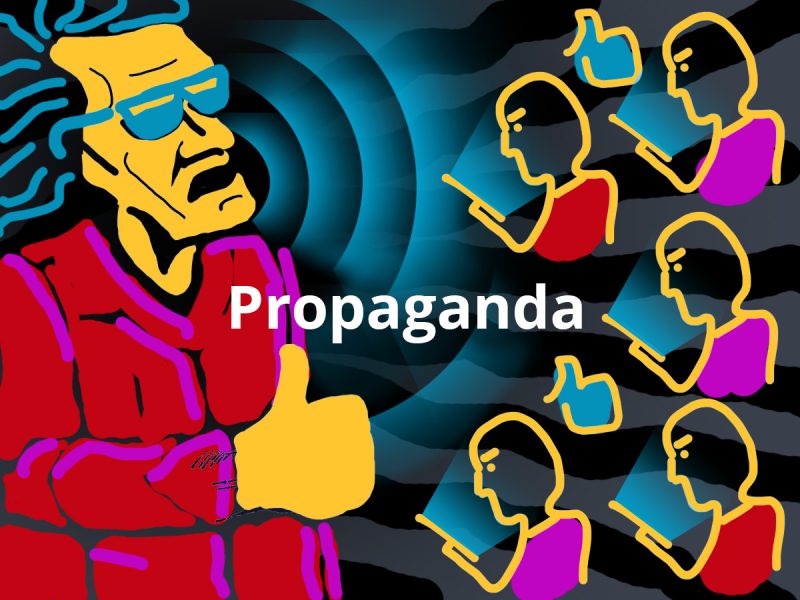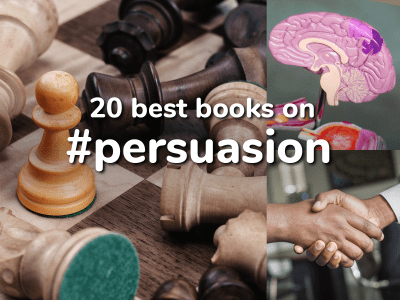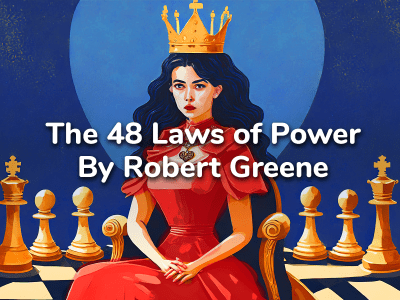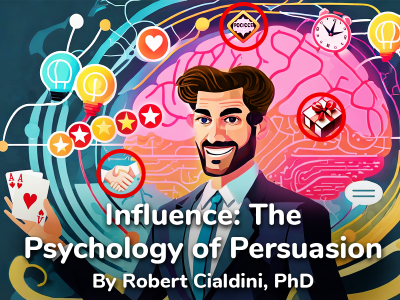When most of us hear the word “propaganda,” we think of manipulation, disinformation, and Nazis. But it wasn’t always like that.
“Propaganda” began as an innocent word. In the 1600’s, the Pope created a group in the Vatican to spread Catholic ideas around the world. Another word for spread is propagate, so it was called the group “for propaganda” and the word was born.
But then in 1914 World War I happened. During the war, the leaders of both sides used media very effectively, to demonize the enemy and motivate their own people to fight. And that kind of left a bad taste in people’s mouths, so “propaganda” became another word for lies.
After that war, Edward Bernays wrote this book with two goals:
- To save the word “propaganda.” He believed it could still mean positive things, like educating people to wash their teeth daily.
- To sell his public relations services. He was a successful business consultant and explains many of his effective publicity techniques in this book.
Who was Edward Bernays?
Often described as “the father of public relations,” Edward Bernays (ThoughtCo.com) was an American business consultant and pioneer in the field of publicity.
His uncle was actually the famous psychologist Sigmund Freud. Freud’s ideas became a foundation of Bernays’ thinking, such as the idea that people have an unconscious mind so they can be influenced without their knowledge.
1. The Invisible Government: Propaganda makes life in a democratic society more organized and practical
Edward Bernays said there is an “invisible government” run by “invisible governors” which really hold the power in every democracy. They organize the “opinions of the masses” so that societies don’t break down into chaos.
That sounds dark and terrifying, but let’s look at what he really meant.
The “invisible government” are the leaders we listen to that guide our thinking about important issues. In a democracy, this is real political power.
The “invisible government” includes:
- The public figures like politicians, journalists, celebrities, writers, professors, ministers, etc.
- The leaders of groups that may be religious, social, ethnic, professional, etc.
- Also the private advisors of those public leaders, who help shape the message behind the scenes.
Why do we listen to leaders? Because modern life is too complicated! For example, most of us don’t have time to carefully research important economic issues. So we rely on others to do the work and present us with a simplified decision: Do you want to vote for the red party or the blue party? This system makes democracy practical for the average person and helps society function smoothly.
Overall, Bernays believed that propaganda can be a force for good. As long as it is truthful and directed towards goals that are positive for society as a whole. Of course, today we would never use the word “propaganda” for positive media campaigns! We may call that education, advocacy, or activism.
The famous professor Noam Chomsky wrote more about the kind of propaganda we usually think of—media campaigns that are manipulative, false, and destructive. He greatly popularized the idea that media can help “manufacture consent” through presenting a distorted picture of events.
For example, Chomsky explained how the opinions presented in the dominant media channels are kept within careful limits: “The beauty of the system, however, is that such dissent and inconvenient information are kept within bounds and at the margins, so that while their presence shows that the system is not monolithic, they are not large enough to interfere unduly with the domination of the official agenda.”
For more, read Manufacturing Consent by Noam Chomsky
(In other places, this idea is often called “The Overton Window” (Mackinac.org). Which means the range of opinions that are considered acceptable by the public. This window can be shifted or narrowed through the right propaganda.)
The invisible government are the leaders who direct public conversation, including top politicians, media personalities, and business leaders. They make democracy more organized and practical by presenting to us only a few key choices.
2. Win the Leader: “The New Propaganda” makes use of group relationships that already exist
Now we’ll switch focus from propaganda in general to propaganda for business. According to Bernays, old-fashioned propagandists tried to influence people’s buying habits individually. For example, one technique was to repeat the same advertising message countless times, because repetition helps even a false message stick in memory.
But “The New Propagandists,” as he calls them, are far more sophisticated because they influence based on group psychology. They make use of existing loyalties, identities, relationships, and dependencies that we have.
Society is better understood not as millions of individuals, but as thousands of overlapping groups:
- Interest-based groups, for people who share the same passion, hobby, or sport. Like a book club or hunting association.
- Religious or ethnic groups, for people who share the same beliefs, background, or values.
- Professional or business groups, like a national union or local chamber of commerce.
- Social or political groups, for those who share the same goals in creating a change in society.
- Informal groups, like all the fans who follow the words of a specific celebrity, like Oprah.
All groups have a leader. So one of Bernays’ most effective propaganda techniques is to influence people by reaching out to the trusted leaders of their groups.
For example, back in his day Americans looked towards Paris as the fashion leader, especially the royalty. So one manufacturer of velvet cloth had some French royals wear velvet clothing. The photos were published in American magazines, causing a flood of demand.
Today big businesses continue to use the same strategy, like Nike will pay top athletes to wear their shoes. And on a smaller scale, there is “influencer marketing,” where a company will pay someone with a social media following to promote their product.
The funny thing is that influencer marketing is usually presented as a revolutionary new strategy, but this book is talking about basically the same idea almost 100 years ago!
Society is better seen as a collection of thousands of overlapping groups. So if you want to influence someone, find what groups they belong to, and who the leaders of those groups are. Win the support of the leader, and you automatically win the followers.
3. Sell What You Stand For: Public relations helps businesses communicate shared values
Eventually people like Bernays gave up trying to save the word propaganda, and switched to “public relations.”
Bernays was one of the first successful public relations consultants, but he lived during a time when almost nobody had a PR department. So he first needed to convince companies that they needed his services.
Here are some benefits of public relations for business:
- To protect reputation. In the 1920’s, there was a movement of journalists (KhanAcademy.org) digging up unethical practices of big businesses. This caused businesses to become much more aware of their public image.
- To maintain stock value. Today most large companies are owned by the public through stocks. So to remain successful, they need the public’s confidence and trust.
- To reach new customers. In the 1920’s, the economy was shifting to mass production, which provides a benefit of lower priced goods, but a problem that factories need to maintain a steady production.
- To stand out from competitors. If businesses compete to have the lowest price, there is eventually no more profit margin. Public relations allows them to instead compete based on values. Let me put this in a more simple way…
People want to buy from companies that share their values. By selling what you stand for, you give people a powerful reason to buy from you, and it costs you almost nothing.
For example, today many marketing campaigns for women’s makeup and fashion communicate values like inclusivity. They feature models of many different body types and skin tones. In a crowded market, why wouldn’t customers choose the brand of product that appears to promote their own values?
Steve Jobs, the co-founder of Apple, was one of the masters of public relations. His marketing strategies didn’t focus on technical features, but on the values Apple stood for, like creativity and non-conformity:
- In 1984, Jobs launched the original Macintosh computer. Most computer companies would talk about “gigabits and megaflops,” but he focused on a story. Jobs made buying the computer feel like a revolution against an evil corporate power—their biggest competitor IBM.
- In 1997, there was Apple’s “Think Different” advertising campaign. These ads featured no products, but only the faces of inspiring heroes like Mahatma Gandhi. The goal was to connect the values of those people with the Apple brand.
Public relations offers many benefits for businesses: protecting their reputation, finding new customers, and standing out from competition. Selling what you stand for, or communicating your values, gives some people a powerful reason to buy your product.
4. High-Spotting: Focusing public attention on certain spots and away from others
Public relations can follow two different strategies:
- Continuous Interpretation. This is managing any news as it happens, such as fact-checking false rumours.
- High-Spotting. This is pointing people’s attention towards specific things, things that you want to represent your whole business. I find this one really fascinating, so let’s talk more about it…
Some methods of high-spotting include:
- Dramatic demonstrations. Bernays is always talking about organizing public events that demonstrate the point you want to make, instead of giving people a rational argument. Here’s a great example I read in a recent book on sales: in 1854 Elisha Otis invented a new elevator safety system, but it wouldn’t sell. So he demonstrated it at an exhibit by cutting the rope holding the elevator… while he was still standing on it!
- Flagship products. Businesses may design a product that is truly the best in the world, or revolutionary in some way, because that brings positive attention to their other products. This is one reason why car manufacturers spend a great deal of money on “concept cars.” These cars are designed not to be sold, but to give people a reason to talk about the car brand.
- Strong symbolic actions. Large companies like Amazon have always been criticized for some labour practices. Trying to defend their public images against these accusations puts the company in a weak position. So instead, in 2008 Amazon decided to pay all their workers at least $15 per hour, far above the US federal minimum wage of $7.25.
Professor Robert Cialdini is probably the world’s #1 expert on the psychology of influence. In his book Pre-suasion, he agrees that rational argument is usually not very persuasive. Instead, we need to pointing people’s attention in the right direction and set the right “psychological frame” for our message.
For example, imagine a real estate agent kept hearing that a certain house was too expensive. What they could try is taking clients to see a much more expensive mansion beforehand. Afterwards, the second house would feel cheaper by comparison. This is what Cialdini means by setting a “psychological frame.”
High-spotting is a public relations technique where you direct public attention to specific things, things you want to represent your whole reputation. You could organize a dramatic visual demonstration, build an outstanding flagship product, or take a strong symbolic stand.
5. Mental Clichés: Provoking a mass reaction starts with understanding people’s pre-existing ideas
If people mostly adopt the ideas of the groups they belong to, then do they think at all? Maybe not.
Bernays believed that people were not individual critical thinkers, but that they were “rubber stamped” with certain ideas by their leaders. We are stamped with “mental clichés”—which are like oversimplified stereotypes about the world and unconscious emotional habits.
A propagandist uses existing mental clichés to create mass reactions. It is a far more effective strategy than trying to change how masses of people think through education.
For example, during World War I some “evacuation hospitals” were set up to treat wounded soldiers. There was public outrage about how quickly soldiers were usually discharged from these hospitals. Why? Because people hold certain mental clichés about what a “hospital” is. Educating the public about why this kind of hospital needed to treat patients differently was too complicated. So they simply changed the name to “evacuation post” and the outrage disappeared.
Here’s another example I read recently in a biography of John D. Rockefeller Sr., who may have been the richest man ever. He became a publicly disliked figure because of his aggressive business practices that involved monopolies and trusts. So his public relations guy Ivy Lee taught Rockefeller to avoid those words, and instead use words like “cooperation.”
In my opinion, this is one of the most unhappy ideas in Propaganda. Because he was able to manipulate large groups of people through publicity campaigns, Bernays came to have a cynical worldview that people don’t think very much at all. Instead, we absorb ideas almost automatically from the people around us, from the groups we are part of, and especially from the leaders we listen to. And this all happens unconsciously—to borrow a word from his uncle Sigmund Freud.
In the classic book 1984 by George Orwell, an all-powerful government controls every part of life. They do it through constant propaganda, mass surveillance, and severe punishment for those who don’t conform. One of their main tools is the control of language. They created a new language called Newspeak, which is like English but with many words removed and forbidden.
In the book, a character says “the whole aim of Newspeak is to narrow the range of thought” so that people literally don’t have the words to express ideas that go against the government. Like we can’t talk about “freedom” if we never learned the idea or the name for it. By controlling language, people in power could forcibly stop many of our mental clichés, even positive ones.
Bernays believed people are rubber stamped with “mental clichés” that shape their thinking in irrational ways. If we want to be influential, we must understand their existing clichés and what images they connect to certain words, like “hospital.”
6. Propaganda Will Survive: The methods of communication are always changing, but human psychology does not
We always need to remember that what Bernays called “propaganda,” today we would simply call publicity or public relations. He didn’t connect the word with deceptive media, but any kind of communication that helps create understanding between the public and a business, politician, etc.
And by that definition, propaganda will never die. The methods of communication will change, but the core ideas of propaganda will always be used. The propaganda techniques that Bernays wrote about 100 years ago are still effective today. Even though the ways we communicate have changed dramatically—from newspapers and radios, to smartphones and podcasts.
The last few chapters explore how propaganda may be used outside of business:
- For politics. He believed that politicians had a duty to be leaders, not just followers of popular opinion. And the most effective way to lead public thought is not with direct argument, but using propaganda techniques like dramatic demonstration and group association.
- For social change. Women only received the right to vote in 1920, a few years before Propaganda was published. However, women’s organizations had already been effective in creating many social changes: more welfare laws, the 8-hour workday, and prohibition of alcohol. (TheMobMuseum.org)
- For education. Higher education relies on funding from state subsidies and/or private endowments, and both of those are helped with a better public relationship. To improve the reputation of a university, they can open publicity offices, college news bureaus, and encourage professors to publicize their latest discoveries in popular media.
While communication methods change over time, the core techniques of propaganda will continue to stay the same. Because people continue to have the same human needs, join groups, and follow leaders.
- Make a list of 5 influencers you could partner with. Let’s say you want to promote a business, product, or idea. First decide who you want to reach, then find out what groups they belong to, and then who the leaders of those groups are.
Because of social media, today it is easier than ever to create partnerships with “influencers” who may reach millions of followers worldwide. And many social media apps like Instagram allow us to see exactly which influencers anyone is following. - Write down in 1 sentence what your business stands for. You can’t “sell what you stand for” unless you first decide on some firm values!
The modern business guru Simon Sinek gives some great advice related to this: “Very few companies can clearly articulate WHY they do WHAT they do. When I say WHY, I don’t mean to make money—that’s a result. By WHY I mean what is your purpose, cause or belief? WHY does your company exist? WHY do you get out of bed in the morning? And WHY should anyone care?” - Ask: What is ONE thing you could offer that is NEW and UNIQUE? Most beginner entrepreneurs make the mistake of trying to make their product appeal to everybody, but they end up speaking to nobody.
As the marketing experts Ries and Trout wrote, “The essence of marketing is narrowing the focus. You become stronger when you reduce the scope of your operations. You can’t stand for something if you chase after everything.” And THAT ONE FOCUS is what you will want to “high spot” in your publicity and advertising.




















Community Notes